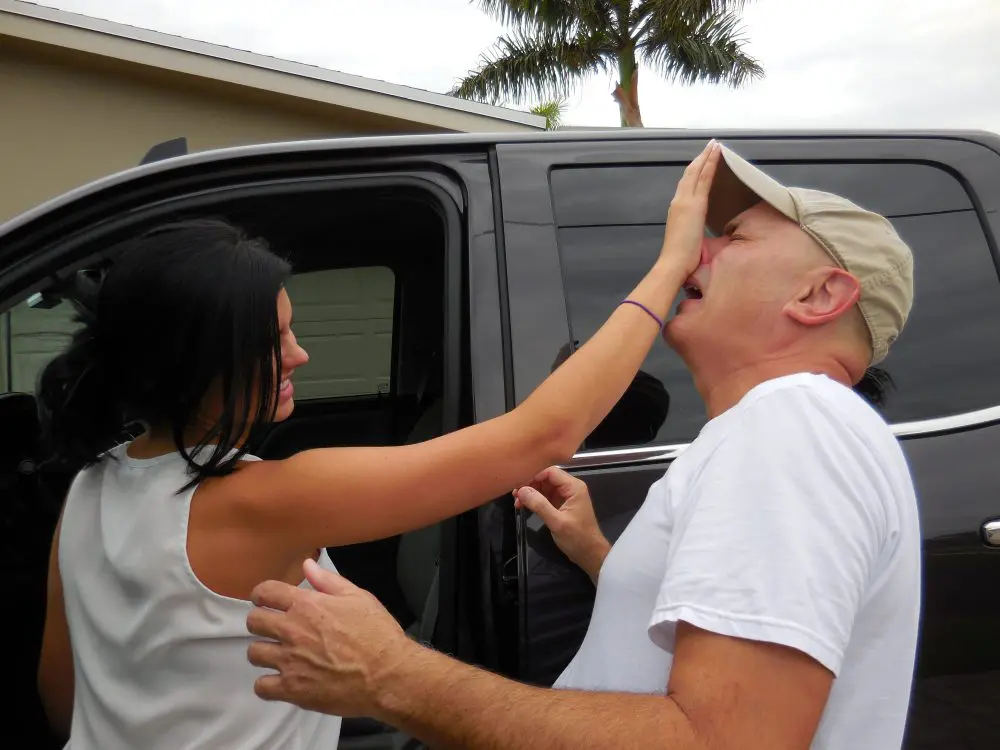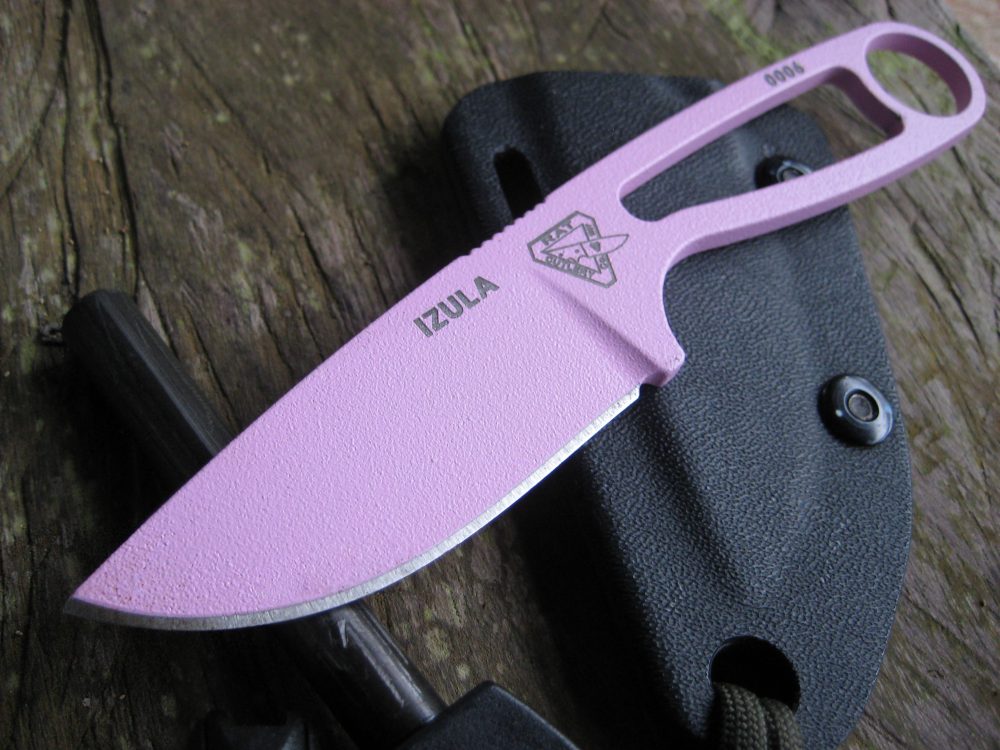If you have read part I of Cool on the Range, Dead on the Street (June 2018 S.W.A.T.), you know I am not a fan of any techniques that may slow you down in a gunfight. I discussed why the power stroking method is the slowest method for chambering a pistol. I also gave my thoughts on scanning left, right, and rear on the flat range after every engagement, and why I think it is a pointless action that may also be doing more harm than good.
In part II, I’m going to highlight two more techniques I feel add zero benefit to tactical shooting, are wastes of movement, and may cost you valuable time in the middle of a gunfight. Of course, the longer you take to put rounds on a threat, the more time the threat has to act against you.
Table of Contents
PRETENDING TO FOLLOW THE TARGET DOWN
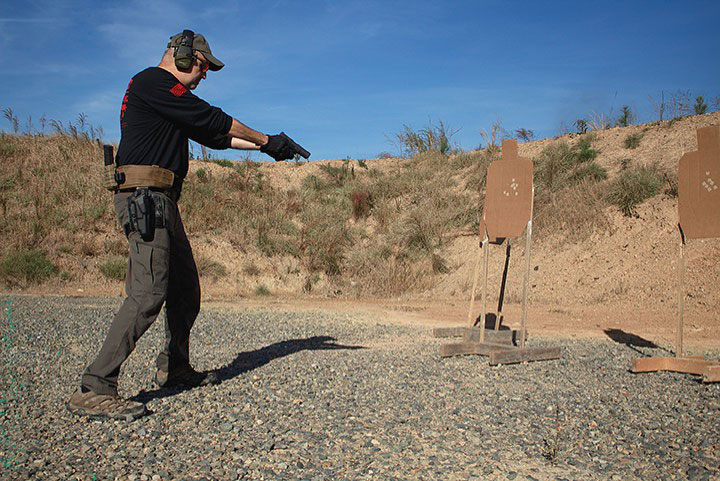
The first technique is one that has become very popular among, shall I say, “tactical YouTubers” (those who make “how to” tactical shooting videos). In the last year, I have noticed in more and more tactical shooting videos that after shooting a target, the shooter then pretends to follow it down to the ground with the muzzle of the gun.
The idea appears to be to simulate that the threat has fallen from shots and, as it is “falling to the ground,” the shooter drives his muzzle down to the ground to the base of the target with the intent of building muscle memory to ensure he is indeed looking at the threat to verify it has been neutralized.
Sounds good, right? After all, why wouldn’t you want to keep your sights and muzzle trained on a threat to ensure it is truly down?
Actually there are a few problems with this technique. First, it assumes that your initial shots were successful in driving the threat down. Second, using this technique begs the question—which I have yet to get a good answer for from those who practice this—when shooting multiple targets, when do you follow the targets down? After you shoot each target or at the end after you shoot all of them?
Concerning the first issue, assuming your initial shots were enough to do the job, then looking down at the ground pretending the target is there seems like you are opening yourself up to prematurely taking your pistol off the target. I don’t think you are doing yourself any favors shooting a string of fire at a target and pretending to follow it down to the ground only to later look at the target and perhaps see that most of your shots were not in a critical area (heart, lungs, head, or spine) to do any instant damage.
FOLLOW THROUGH: WHAT YOU SHOULD BE DOING
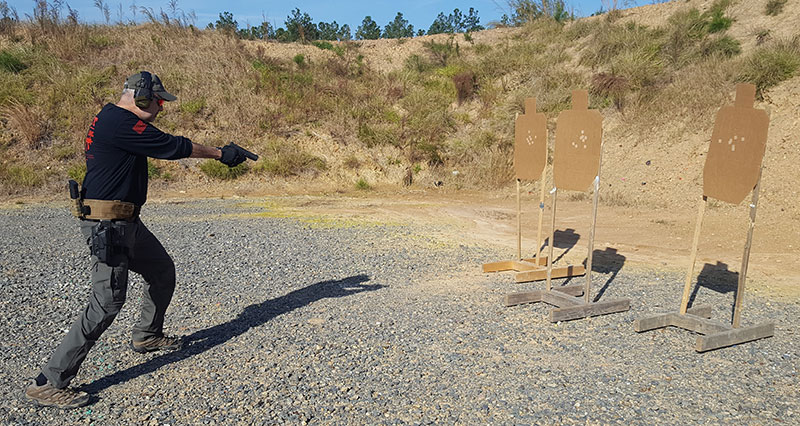
Whether it’s one or a dozen threats, what I think you should practice is re-indexing all threats with the muzzle, looking to ensure you have good kill-zone hits. Ideally while you are shooting, you should be seeing where your sights settle between shots. If they settle off the kill zone or worse off target, chances are you have a weak hit or a complete miss. If that is the case, you should make it up instantly.
Example: While shooting a double tap, if I notice after my second shot the sights settled on the C-zone of a USPSA target, there’s a good chance it was a C hit not an A (kill zone). I instantly make it up, turning a double tap into a three-round string because to me, a double tap means two kill-zone hits, not just two shots fired hitting anywhere. After that, I would again re-index the target with the gun (sights and muzzle) to confirm I have the desired number of rounds in the kill zone.
As for the question of when do you pretend to follow down when faced with multiple targets: Do you shoot a target, follow it down, then proceed to the next target? Or do you shoot all the targets, then sweep the ground in front of them all at the end?
I would like to hear from those who practice this technique. It seems to me that it only makes sense to shoot them all first, then trace the ground around the targets, simulating they have all fallen.
The other way—shooting then aiming at the ground before going on to the next target—seems like you will just be giving the other threats time to shoot at you. So if it is the former (shoot all threats then trace the ground), that requires you to have two different reactions, based on if one is faced with single or multiple threats. Wouldn’t it
be easier and more natural to use a technique that is the same regardless of the number of threats?
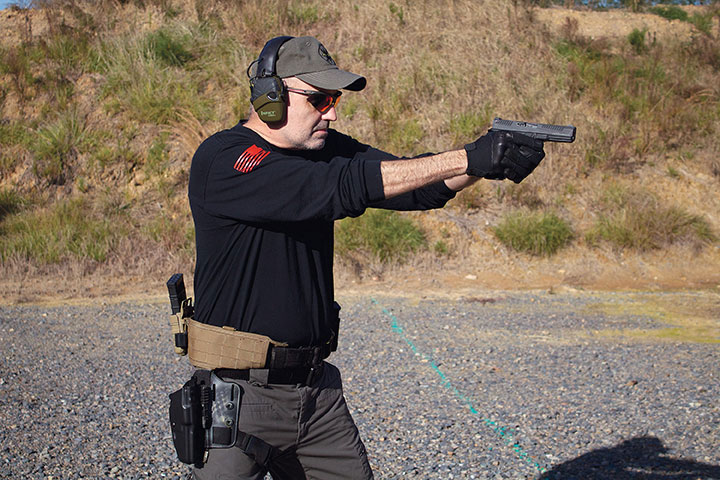
This is why this technique seems to have been dreamed up by someone who has no practical experience facing real threats. By practicing aiming at the ground after shooting a target, you may not remember to watch the threat in a real-life gunfight. Of course, those with real-world experience will tell you otherwise.
Under pressure, your brain has already taken care of threat focus. That is why most tactical instructors spend so much time making students aware of hyper focus or “tunnel vision” on a threat. That occurs when faced with danger. Your body and mind’s built-in danger response will have you focusing on a threat until your mind subconsciously deems it no longer a danger.
That is why, regardless of what the standard engagement response to a threat is in training by police—double tap, single shot, etc—watching body camera footage of officers in real shootouts shows that, more often than not, the natural reaction by officers in danger is to continue to shoot a threat with multiple rounds until it falls, stops moving, drops a gun, or makes another action that conveys the visual message that it is no longer a threat.
Your natural threat response will take care of you being able to focus on a threat. That is the number one reason I think that, while it may look “tacticool,” training to follow a threat down is a complete waste of time. If you want to practice watching/driving targets to the ground, there are better alternatives than staring at the base of a target stand.
Several different falling targets are available (some inexpensive) that will fall or drop only if they receive kill-zone hits: torso, head, or both. Dropping targets add more realism in training because targets only drop from good kill-zone hits.
When faced with multiple targets, you are forced to use good shot placement (to make the target fall) before you can move on to the next target, which I think is a lot better than make believe and staring at target stands after you shoot.
ROLLING THE RIFLE OVER
I first saw the next technique being utilized by fellow Special Forces soldiers. About ten years ago, in a Special Forces training video for close quarter combat (CQB) train¬ing, I noticed that when practicing transitioning, prior to going to the pistol when the carbine was empty, they would roll the carbine over, quickly look into the chamber, then transition to the pistol. I assume the reason for the quick look was to see why the rifle stopped shooting.
I don’t know which SF Group the video was from, though it was not 5th or 3rd Special Forces Group, as I have served in both.
I don’t know if the SF guys decided it was a good thing to do, or if they picked it up from some outside source, but I instantly thought, what’s the point? I can see the good intent with the technique: Isn’t taking a split second to diagnose why the rifle stopped a good idea? So you might be able to fix it quickly and save yourself from having to transition to the pistol?
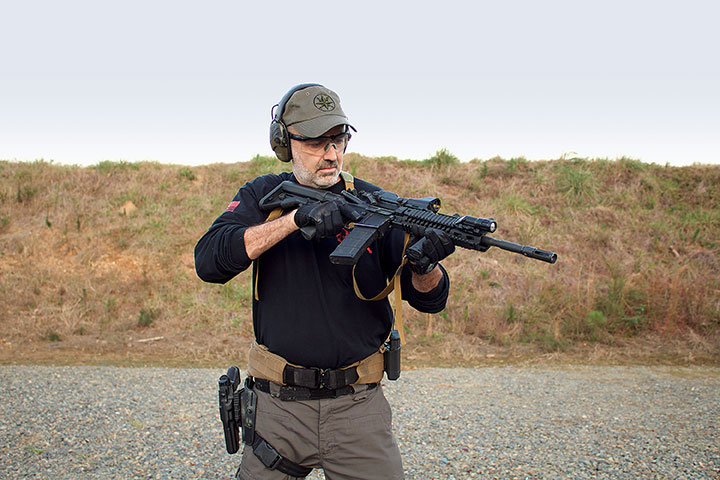
Perhaps, but the problem is that no one seems to make an effort to really see what the issue is. Instead, from every video I have seen of shooters rolling the gun over to peek into the chamber, they transition to the pistol regardless of the condition of the rifle.
If you’re not going to do anything to get the rifle back up and running, why waste time looking into the chamber? Why not just transition to the pistol and not spend precious time looking at the gun, not to mention taking your eyes off the threat during that time?
Even if you make a real effort to look at the chamber to see if the problem is something you can remedy and not have to transition to the pistol, doing it every time the rifle goes click is still flawed, because it will only work if the environment lets you see into the chamber in the first place.
What if it’s at night or you are operating in a poorly lit room? Chances are you are not going to have enough light to see into the chamber. By doing this technique every time on the flat range, you are building an automatic response that only works under very specific conditions.
Plus, chances are that if the carbine goes click while in the middle of engaging a threat, the threat is still active. Do you really want to waste time getting to the pistol?
The real flaw with always peering into the chamber prior to going to the pistol is it should not be based on the condition of the rifle, but on the distance to the threat. For ex¬ample: If your rifle goes down 100 yards from a threat, which will be faster getting rounds back on target? Transitioning to the pistol and hoping to make a 100-yard shot with rapid and accurate rounds to finish the threat, or seeking cover to get the rifle back up and finish the fight with that? The answer for most of us is to get the rifle back up.
But what if the carbine goes down at room distance and you are standing in front of a still-active threat? Does peer¬ing into the chamber knowing you don’t have time to do anything about it help you get to the pistol any faster? Of course not. Deciding when to transition should be dependent on the threat distance. Is it within practical pistol distance or not?
For many, anything under 20 yards may be close enough that going to the pistol and getting hits would still be quicker and only then trying to get the rifle reloaded or a malfunction cleared. Beyond 20 yards, I recommend testing yourself to see at what distance you can quickly and accurately place rounds on target.
TESTING YOUR TRANSITION DISTANCE
Finding the distance where you can and cannot transition fast enough to be practical is pretty simple. But before you do this, decide at what point based on length of time it takes you to get a hit with a pistol. Is it too much time, and getting the rifle back up would be better?
There is no real set answer to how much time is too much, but I recommend basing it on two factors: how fast you can reload a rifle versus how fast you can draw a pistol and hit a target at room distance.
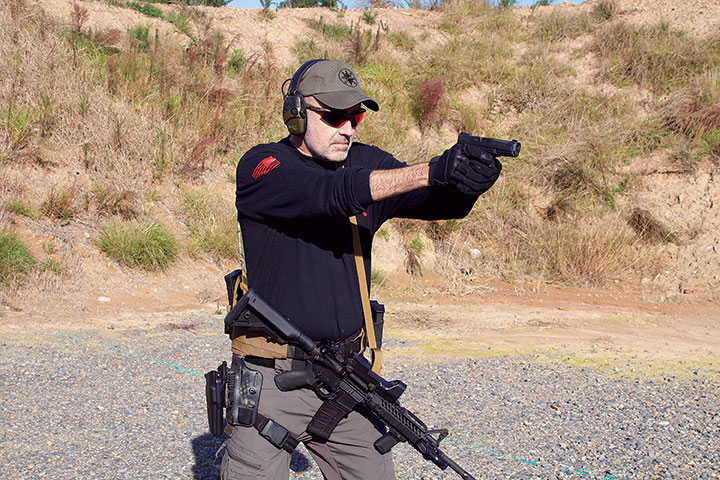
Let’s say you can transition, draw your pistol and hit a target at seven yards (room distance) in 1.5 seconds, and it takes you three seconds to fire a shot from a rifle then per¬form a bolt-lock reload and shoot a second shot at that same distance.
You now have a baseline: If it takes you over three seconds to transition to a pistol and get a hit, then it would be better to just get the rifle up. After all, nothing is going to make you feel more inadequate than going against an enemy armed with an AK at rifle distance, and you are shooting back with just a pistol.
Using this baseline, you know that anything near three seconds to get a hit with a pistol, you would be better off get¬ting the rifle back up. It’s time to turn that into an actual distance you can use as a reference, for when you should and should not transition.
Starting at seven yards, where you shot that 1.5 transition with the pistol, take a couple steps back and repeat the same one-shot rifle, one-shot pistol transition. The goal is staying as close to that 1.5 seconds as possible.
Keep repeating, taking a couple steps back and shot-to-shot transition, until it takes you three seconds to get a hit with the pistol. That distance is now your point of diminish¬ing returns. Let’s say it’s 15 yards. (It will be different for everyone based on their skill with a pistol.)
One person might be able to get to the 25-yard line before the time it takes to make hits with a pistol is too long, while others may be forced to transition a lot closer (or even farther) from the target.
The important thing is, in doing this, you will learn what your max distance is where you can effectively perform a transition. So instead of wasting time practicing some automatic waste of movement (rolling the gun to look into the chamber), you will now base when to transition on the distance you know you can make the fastest hit with.
This also sets you up with a quantifiable way of measuring your progress in practice. Let’s say you can quickly transition out to 15 yards. You can set goals working toward beating that distance. This is more efficient than adopting a generic technique based on hoping you have the time and correct lighting for it to work.
The technique of automatically trying to look into the chamber every time the rifle goes click also ignores a key thing most experienced AR shooters know, which is the difference in feel between a rifle locking empty on the last round and a rifle jamming from a malfunction. The feel of an AR going empty is distinct. If you can tell by feel, that negates the reason for looking into the chamber.
THE WRAP UP
What separates a trained shooter from a novice? It’s not the number of cool techniques one knows. It’s knowing which techniques to use and when to apply them. A trained shooter’s manual of arms is not only usually shorter than a novice’s but also more refined and based on the circumstances. Instead of relying on some generic techniques, find out what you are capable of shooting, then base your reactions and methods on that.



